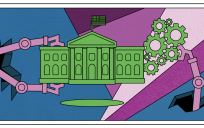President Joe Biden’s election spurred growing discussion of diversity in the federal workforce — the need for more of it, the steps to achieve it and the best ways to reach desired outcomes. As the corporate world grapples with its own understanding and objectives related to diversity, equality and inclusion, eyes are on the Biden administration to back up the talk by walking the walk.
Already we see the early signals of prioritized diversity, including in Biden’s cabinet. He pledged to create the most diverse cabinet in U.S. history, reflecting the people he was elected to lead and represent globally. Already, his cabinet has more women, more nonwhite members, fewer white men and more members with government experience than the two presidents before him. And, of course, Vice President Kamala Harris is included in the 11 women, six African Americans, four Hispanics and the first Native American in a cabinet post.
“This is the first in American history that the cabinet looks like America,” Biden declared at the first Cabinet meeting on April 1. “That’s what we promised we were going to do, and we’ve done it.”
But, of course, the work is far from done. Down the chain of command, agency and department leaders see the example and understand the marching orders. But it’s less clear how to get it done. While we may or may not see further directives from the executive branch offering such guidance, there is one asset every agency has that can help them get started: data.
Data-Driven D&I Progress: 3 Key Steps
Who are we? Who do we want to be? These are fundamental questions for any D&I initiative, and data helps answer both questions. Data enables organizations to take a snapshot of their current demographics and grow from that — a critical first step.
1. This first step is about more than just “getting the data.” Not only does that data have to be analyzed and contextualized, but it also — perhaps first — has to be disaggregated to a granular level. Aggregated data limits what the data represents by not breaking it down to a granular level. By disaggregating the data, agency leaders can help eliminate skewed data practices, processing or analysis.
Everyone knows the saying by now: “You’re entitled to your own opinion, but not your own facts.” Data itself is factual in nature, but it’s subject to interpretation. Everyone looks at data a little differently; there’s no centralized authority on how it should be deciphered, evaluated or applied. When putting the data together, those involved may need to agree on a “factual intersection” or foundational baseline to work from. In fact, that’s probably a best practice.
2. With the data fundamentals in place, the second step is outlining and embarking on the series of bite-sized objectives that will move the needle toward inclusivity and clarify executive goals. In this step, decision-makers should engage their human resources leaders and also take advantage of the free tools and resources available to organizations to help formulate D&I plans, including defining metrics and deliverables.
Creating actionable, realistic, data-driven objectives and metrics should be an inclusive endeavor itself, so it’s important to put your data out there for public accessibility. It’s OK to acknowledge if you need to do better, to ask for input, and to identify where and how your department can improve. Not only is transparency inherently important, but it’s also a useful way to crowdsource ideas, demonstrate commitment to the betterment of society and make D&I priorities clear to prospective talent.
3. The third step in getting agencies on a sustainable path toward improving workforce D&I is leveraging the work done in the first two steps to garner and promulgate buy-in. From the executive suite and board rooms to the college campuses ripe for recruitment, it’s critical to invest in federal workforce diversity. That includes current personnel and a robust pipeline for the future. A failure to buy into D&I, and to demonstrate that buy-in through investment and nontraditional recruiting, ultimately results in a failure to attract the young talent badly needed in the government.
The U.S. can’t afford to lose out on the contributions this socially conscious generation promises the federal workforce. Real change only transpires if we as a society are able to change perspectives, and data can help. After all, the data makes it clear that diverse teams are more effective, efficient and beneficial to whole organizations—and data doesn’t lie.
Otho Lyon is Cloudera’s Senior Director of Global Service Delivery—Americas. After spending much of his Cloudera career dedicated to public sector clients, Otho now oversees the strategy and delivery of services for the company’s solutions for clients throughout the Americas. He continues to play a key role in digital transformation projects and in ensuring excellence in the knowledge, training and satisfaction of Cloudera’s workforce. Otho is based in the Raleigh, North Carolina, area.





Totally agree on your point about disaggregating data!
Thanks for the comment Pearl, it seems that aggregating data is a general practice that needs to change in order to get to the granular level and allow data to drive leaders to make informed decisions.